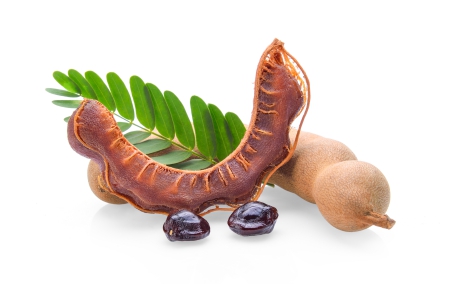Tamarind is a leguminous tree belongs to Fabaceae family and bears edible fruits. It is well known for its therapeutic properties and has been traditionally used for treating diarrhea, abdominal pain, dysentery and several gastrointestinal problems as it has carminative as well as laxative effects. It is also well known for its anti-inflammatory activities and wound healing capacity.
Characteristics
- The fruit has an acidic, fleshy and juicy pulp
- Fresh and unripe tamarind has green color, but it becomes brown or reddish when in matures
- The taste of the fruit is ranging from sweet to sour
- It has a tart and tangy flavor
Nutritional overview
- Tamarind contains significant amount of carbohydrates and dietary fibre
- It contains very less amount of protein
- It contains negligible amount of fat
- It produces desirable calorie on its oxidation as it has significant amount of carbohydrate as well as some extent of fat
- It contains several vitamins like Vitamin C, Vitamin K, thiamine, riboflavin, niacin, pantothenic acid and folic acid
- It also rich in various trace elements like calcium, phosphorus, potassium, iron, sodium, magnesium
- It contains numerous biologically active compounds such as catechin, epicatechin, procyanidin tetramer, procyanidin trimer, procyanidin pentamer, procyanidin hexamer, taxifolin, tartaric acid, malic acid, citric acid, quinic acid and succinic acid

Tamarind juice
Juice extracted from tamarind can also be consumed as it has various health benefits such as it helps to improve blood circulation and immunological responses. Individual who want to reduce their body weight can consume tamarind juice at least once a day. The most important feature of tamarind juice is that it has a better shelf life hence it can be stored for a long period of time.
Health benefits
Antioxidant activity
- Tamarind is considered as the powerhouse of antioxidant
- Polyphenolic compounds of tamarind such as catechin, epicatechin, procyanidin and apigenin help to prevent oxidation of cellular components by neutralizing free radicals
- Tartaric acid of tamarind also exerts antioxidant activities
- Geraniol is another important component present in tamarind has strong antioxidant activity and is associated with suppressing the growth of pancreatic tumor
Role on preventing obesity
- It is very beneficial to be consumed by obese individual as it has anti obese benefits
- It is associated with increasing lipolysis (breaking down of fat) as well as catabolism that help in weight reduction
- Hydroxycitric acid of tamarind plays significant role in reducing body weight
- It is also related with enhancing serotonin level of the body, which reduces food intake by controlling appetite and promotes calorie expenditure

Role on blood purification
- Consumption of tamarind or its juice is very effective for purifying blood as it helps to reduce the concentration of free radicals because it is rich in antioxidant and other nutrients like minerals, fibre and folic acid
- It also helps to inhibit the accumulation of toxins in blood vessels
Role on nervous system
- Consumption of tamarind is associated with improving nerve functions as it helps to maintain the refluxes
- Vitamin B complex of tamarind are considered as most significant elements help in improving brain functions
- Another important constituent of tamarind is xyloglucan, which helps to repair damaged brain cells plus spinal cells. It also stimulates their growth
- It helps in the migration as well as reattachment of cells to nervous system
Role on excretion
- It especially helps in fluoride excretion. It has seen that consumption of tamarind has a proportional relationship with urinary fluoride excretion
- It helps to prevent fluorosis by preventing fluoride accumulation in body (as it increases urinary fluoride excretion)
Role on eye

- It helps to protect the eye from damages and promotes vision
- Vitamin A content of tamarind plays important role in protecting cornea and related with decreasing various disorders like conjunctivitis, corneal xerosis, keratomalacia, bitot’s spot
- It is also related with reducing the prevalence of macular degeneration
Role on skin
- Alpha hydroxy acids (AHA) component of tamarind is responsible for exerting exfoliating activity, which helps to unclog pores as well as blemishes
- It also helps to make the skin clear and spot free
- It helps to decrease the progression of aging process
Therapeutic applications
Effect on blood pressure
- It is extensively used for reducing hypertension
- It helps to maintain normal blood pressure as it is an effective vasodilator and a good source of potassium
Effect on atherosclerosis
- Antioxidant, potassium and fibre components of tamarind are responsible for reducing triglyceride, VLDL and LDL concentration thus helps to reduce the consequences of hypercholesterolemia
- It helps to inhibit the formation of fatty plaque within artery and reduces the prevalence of atherosclerosis and promotes cardiac health
Hypoglycemic activities
- It is beneficial to be consumed by diabetic patient
- It helps to regulate the concentration of free sugar within blood by inhibiting the activity of alpha amylase (carbohydrate splitting enzyme)
- Magnesium component of tamarind also helps in reducing the prevalence of type 2 diabetes mellitus

Effect on digestive health
- It is used as an important preventive measure for inflammatory bowel disease such as Crohn’s diseases and ulcerative colitis
- Fibre content of tamarind is responsible for improving peristalsis and bowel movement that makes the defecation process easier and prevents constipation
- Potassium bitartrate, malic and tartaric acids of tamarind also play significant role in preventing constipation
- It is also used to prevent stomachache
Effect on maternal health
- It has seen that it is used by a wide group of women during their pregnancy for preventing morning sickness (general complication of pregnancy characterized by nausea and vomiting)
- It is also used in pregnancy for preventing constipation (another harmful complication) as it has potent laxative effect
Effect on hepatic health
- It is widely used as a preventive tool for alcoholic as well as non-alcoholic liver disease
- It helps to protect the liver from oxidative damages and inflammation
- It also helps to detoxify the liver
It is used as fever controlling medication and especially effective against malaria

Its anti-inflammatory activities protect heart by reducing cardiac inflammation
It is also used for reducing the prevalence of renal calculi
General consideration of consuming tamarind
- It is better to soak tamarind in warm water at least for 10 minutes before use
- Then the soften tamarind should be squeezed by the finger. After that, the juice should be strained, and pulp should be discarded
- It is better to store tamarind in a cool place especially in refrigerator
- Raw and ripe both tamarinds can be used in cooking
- It can be used as a condiment in sauce, dips and curries
Risk factors
- Excessive consumption of tamarind may cause gas production and other gastrointestinal problems as it contains significant amount of fibre
- It has strong hypoglycemic effects. So, individuals who are already on hypoglycemic drugs on insulin should monitor their blood sugar level while consuming tamarind to avoid the risk of hypoglycemia
- It often causes allergy to some individual if consumed in large amount

Source:
Arshad, M.S., Imran, M., Ahmed, A., Sohaib, M., Ullah, A., Nisa, M.U., Hina, G., Khalid, W. and Rehana, H., 2019. Tamarind: A diet‐based strategy against lifestyle maladies. Food science & nutrition, 7(11), pp.3378-3390.
Azad, S., 2018. Tamarindo—Tamarindus indica. In Exotic fruits (pp. 403-412). Academic Press.
Banu, M.S., 2018. CHEMISTRY OF TAMARIND. Tamarind Science and Technology, p.33.
Borquaye, L.S., Doetse, M.S., Baah, S.O. and Mensah, J.A., 2020. Anti-inflammatory and anti-oxidant activities of ethanolic extracts of Tamarindus indica L.(Fabaceae). Cogent Chemistry, 6(1), p.1743403.
Naik, T.I., Shrikanth, P. and Mundugaru, R., 2017. Wound healing activity of Tamarindus indica Linn. seed and cork ash. Journal of Ayurveda Medical Sciences, 2(1).
Nivesh Krishna, R., Roy, A. and Ezhilarasan, D., 2020. Aqueous extract of Tamarindus indica fruit pulp exhibits antihyperglycaemic activity. Avicenna Journal of Phytomedicine.
Pal, D. and Mukherjee, S., 2020. Tamarind (Tamarindus indica) Seeds in Health and Nutrition. In Nuts and Seeds in Health and Disease Prevention (pp. 171-182). Academic Press.
Rana, M., Sharma, P., Mahima, R.C. and Sharma, P., 2018. Proximate and phytochemical screening of the seed and pulp of Tamarind indica. Journal of Medicinal Plants, 6(2), pp.111-115.



